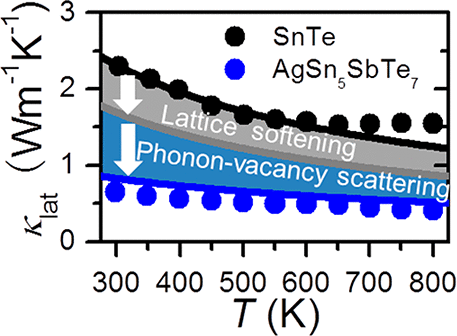当前位置:
X-MOL 学术
›
ACS Energy Lett.
›
论文详情
Our official English website, www.x-mol.net, welcomes your
feedback! (Note: you will need to create a separate account there.)
High Thermoelectric Performance in SnTe–AgSbTe2 Alloys from Lattice Softening, Giant Phonon–Vacancy Scattering, and Valence Band Convergence
ACS Energy Letters ( IF 19.3 ) Pub Date : 2018-02-12 00:00:00 , DOI: 10.1021/acsenergylett.8b00137 Gangjian Tan 1 , Shiqiang Hao 2 , Riley C. Hanus 2 , Xiaomi Zhang 2 , Shashwat Anand 2 , Trevor P. Bailey 3 , Alexander J. E. Rettie 4 , Xianli Su 1, 5 , Ctirad Uher 3 , Vinayak P. Dravid 2 , G. Jeffrey Snyder 2 , Chris Wolverton 2 , Mercouri G. Kanatzidis 1, 4
ACS Energy Letters ( IF 19.3 ) Pub Date : 2018-02-12 00:00:00 , DOI: 10.1021/acsenergylett.8b00137 Gangjian Tan 1 , Shiqiang Hao 2 , Riley C. Hanus 2 , Xiaomi Zhang 2 , Shashwat Anand 2 , Trevor P. Bailey 3 , Alexander J. E. Rettie 4 , Xianli Su 1, 5 , Ctirad Uher 3 , Vinayak P. Dravid 2 , G. Jeffrey Snyder 2 , Chris Wolverton 2 , Mercouri G. Kanatzidis 1, 4
Affiliation

|
We report on the underlying mechanism that enables the SnTe–AgSbTe2 system to exhibit superior thermoelectric figure of merit (ZT) compared to its parent compound SnTe. We show that AgSbTe2 alloying has a profound impact on the band structure of SnTe by converging the energies of its light and heavy valence bands, leading to significantly enhanced Seebeck coefficients. We have also unraveled a significant connection between alloying and defect stability in this system, wherein the Sn vacancy concentration increases significantly when Ag and Sb are alloyed on the Sn site. The increased Sn vacancy concentration dramatically reduces the lattice thermal conductivity through both lattice softening and phonon–vacancy scattering to ∼0.4 W m–1 K–1 at 800 K. Consequently, a ZT value of 1.2 at 800 K for AgSn5SbTe7 can be achieved by doping I on Te sites. This represents a 300% improvement over pristine SnTe, outperforming many reported SnTe-based thermoelectric materials.
中文翻译:

晶格软化,巨大声子-空位散射和价带收敛的SnTe-AgSbTe 2合金的高热电性能
我们报告了使SnTe–AgSbTe 2系统与其母体化合物SnTe相比表现出优异的热电性能因数(ZT)的潜在机制。我们表明,AgSbTe 2合金化通过融合其轻和重价带的能量,对SnTe的能带结构产生深远的影响,从而导致塞贝克系数显着提高。我们还揭示了该系统中合金与缺陷稳定性之间的重要联系,其中,当将Ag和Sb合金在Sn部位时,Sn的空位浓度会显着增加。锡空位浓度的增加通过晶格软化和声子-空位散射将晶格热导率大大降低至〜0.4 W m –1在800 K时为K –1。因此,通过在Te部位掺杂I可以使AgSn 5 SbTe 7在800 K时的ZT值为1.2 。这代表比原始SnTe改善了300%,胜过许多报道的SnTe基热电材料。
更新日期:2018-02-12
中文翻译:

晶格软化,巨大声子-空位散射和价带收敛的SnTe-AgSbTe 2合金的高热电性能
我们报告了使SnTe–AgSbTe 2系统与其母体化合物SnTe相比表现出优异的热电性能因数(ZT)的潜在机制。我们表明,AgSbTe 2合金化通过融合其轻和重价带的能量,对SnTe的能带结构产生深远的影响,从而导致塞贝克系数显着提高。我们还揭示了该系统中合金与缺陷稳定性之间的重要联系,其中,当将Ag和Sb合金在Sn部位时,Sn的空位浓度会显着增加。锡空位浓度的增加通过晶格软化和声子-空位散射将晶格热导率大大降低至〜0.4 W m –1在800 K时为K –1。因此,通过在Te部位掺杂I可以使AgSn 5 SbTe 7在800 K时的ZT值为1.2 。这代表比原始SnTe改善了300%,胜过许多报道的SnTe基热电材料。











































 京公网安备 11010802027423号
京公网安备 11010802027423号